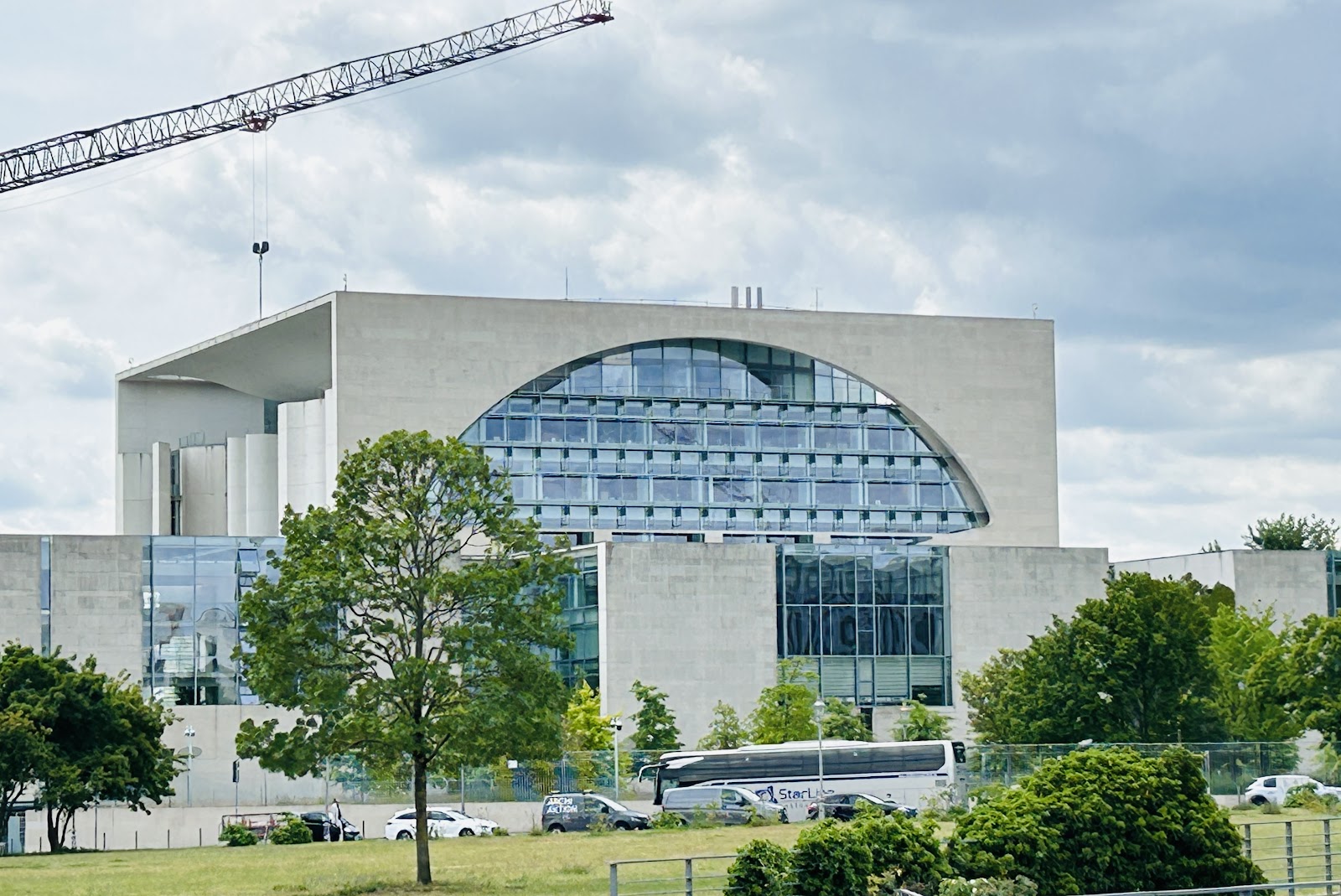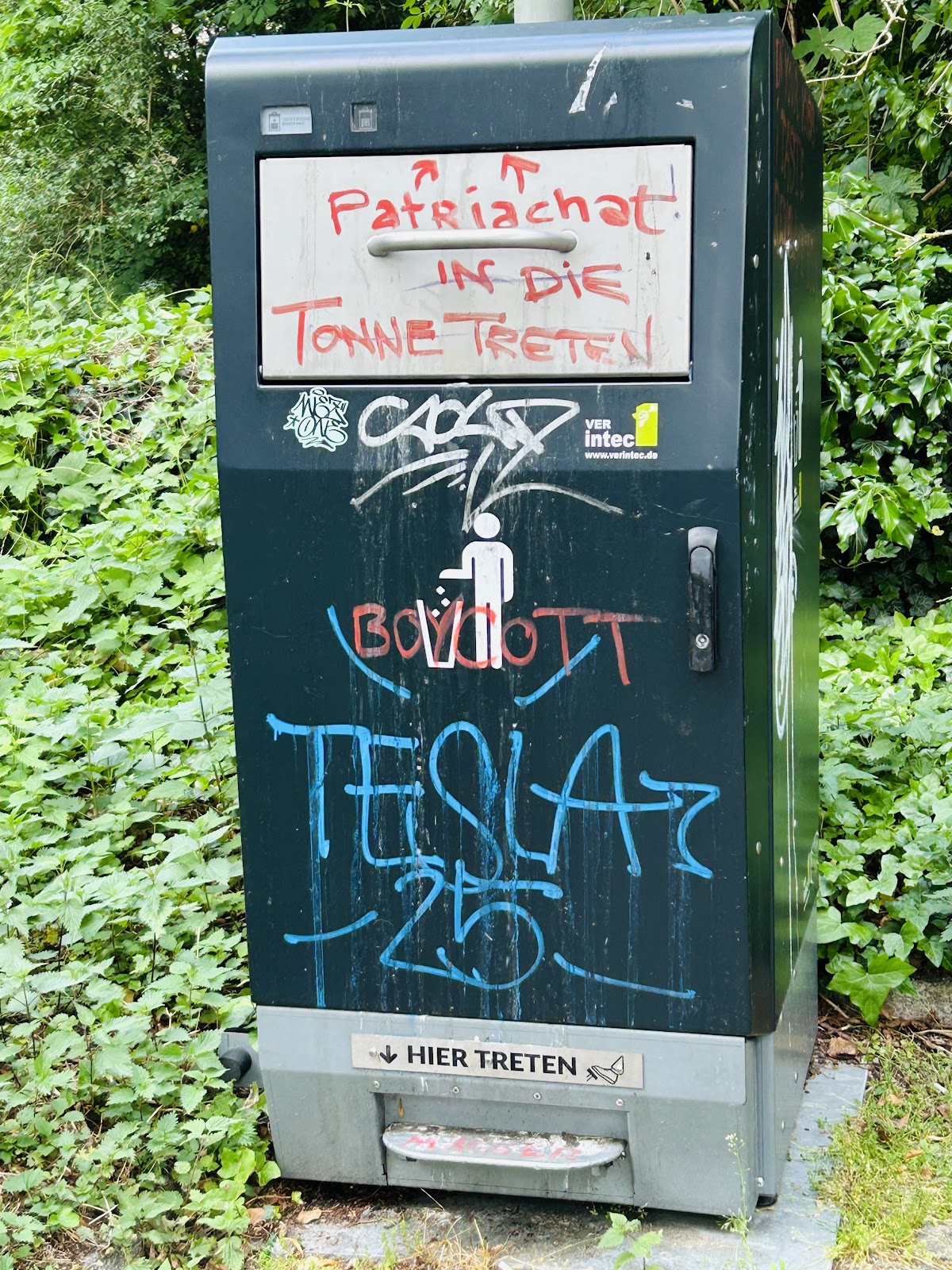 |
| Dammtor station, Hamburg |
A long day yesterday, but a generally very enjoyable one (I’m writing this on the 28th). Early in the day, we took the train from Hamburg to Berlin. It was scheduled to depart from Dammtor station (of which I took some photos; the architecture of Ernst Moeller, who designed the station in 1903, is impressive) at 9:28 but actually left Hamburg later. In typical German fashion, everything is calibrated by a clock which announces (via a computerized screen at the platform where you’re waiting) the exact moment a train is scheduled to arrive and then depart. Voice announcements routinely told us this information, adding that there was a “medical emergency” on our line (our friend W. thought this was likely a suicide) that was responsible for the delay, and then for an alternative route we ended up taking.
En route to the station to catch the train, we walked through the delightful Planten un Blomen gardens. We had been there on our first visit to Hamburg in 1990. I remember on that visit being bowled over by the magnificent fragrance of a rose called Königin von Dänemark, which I learn from googling was introduced in Germany by James Booth & Sons in 1826, and also goes by the name Naissance de Vénus. I didn’t find this old friend on our quick walk through Planten un Blomen yesterday, but saw instead, this time around, potted palm trees and some fig trees (not in pots) growing around an overlook with a pond below. I wonder if this is a particularly warm pocket of the park. I’m surprised to find figs growing in Hamburg, but again in Berlin yesterday, I saw several in front of houses in the Pankow neighborhood.
The train we took from Hamburg to Berlin was clean and commodious. W. had reserved seats for us with a table between the four chairs in a quiet zone, a Ruhebereich. Across the aisle from us was a family that seemed to consist of a husband and wife and the wife’s parents. After claiming their seats, they went, two of them, to the dining area of the train and came back with three bottles of wine, one white, one rosé, and one red, and proceeded to open these and pour them into small glasses. The white wine foamed, so I’m assuming it was a crémant. After they had all toasted and sipped, the wife then opened a tinfoil packet she’d brought and parceled out four homemade cupcakes to go with the wine. The family then proceeded to bring out a deck of cards and played some kind of game with chips for gambling.
After we reached Berlin a bit before noon, W. and K. walked us to the chancellor’s building, the Brandenburger Tor, and the Reichstag. We also spent some time standing on a bridge over the Spree near the Hauptbanhof, watching ships with tourists ply up and down the river. It was a pretty May day, drier and sunnier than in Hamburg, a pleasant day to walk outside.
We walked as well through the Tiergarten where I enjoyed seeing a statue of Goethe sculpted by Fritz Schaper in 1880, and walked through Brandenburger Tor where a violinist was playing in Platz des 18. März with a large group of tourists watching and listening. Prior to that the same violinist had been at the memorial to the Roma and Sinti murdered in Europe during the Holocaust, which we visited before we moved on to the memorials to Jews murdered in Europe during the Holocaust and to homosexuals persecuted under Nazism.
 |
| Memorial to Roma and Sinti murdered in Europe during Holocaust, Berlin |
 |
| Memorial to homosexuals persecuted in Germany under Nazism, Berlin |
These were all grim to see. The memorial to the Roma and Sinti had photographs of people killed by the Nazi regime, and a video explaining this history. The mazelike arrangement of the memorial to murdered Jews, with rectangular concrete stelae of various heights and long straight pathways between the rows of stelae, is disorienting to walk through. One goes up and down and as the stelae become higher, one begins to wonder if one will ever find a way out. And this, surely, is the point of the whole memorial, the no-exit horror show facing Jews who had not managed to escape before the Nazis slammed their iron curtain down….
At 1:30 we rendezvoused with W. and K.’s daughter T., who lives in Berlin. We hadn’t seen her in 25 years, and it was nice to see her again now as a grown woman living on her own and apparently doing very well as a teacher. She specializes in teaching Lebenskunde, life skills, to children and pre-teens. As I told her, she’s carrying on her father’s life’s work though not in an explicitly religious context. The skills she teaches focus on areas like gender and sexual orientation, forming and sustaining friendships, and so on.
T. had spotted an Indian restaurant that has some vegan offerings — she’s vegan and wanted to find someplace that would allow her to choose dishes she can eat — and we headed there with a roundabout walk that allowed us to see a statue of Bertolt Brecht by Fritz Cremer in a small square named for Brecht, and to see the nearby theater, the Ensemble, in which Three-Penny Opera was first performed.
Then on to the Indian place, the Anand on Albrechtstraße, a side street that has, T. told us, some “real” restaurants as opposed to the many tourist-leaning ones lining the nearby main street, Friedrichstraße. After we’d eaten a meal of various Indian dishes from the buffet menu (the four of us chose that while Anna asked for some vegan offerings), we walked around the corner to an Italian restaurant, Italofritzen, and had coffee.
Then on to visit C. and A. and their children E. and E. in the Pankow neighborhood of what had previously been East Berlin. Again, it has been quite a few years since we’ve seen C. After having done his alternative military service, he came and stayed with us a week or so, and then returned to Germany and began working and married. His parents R. and C. have both now died, and we wanted to see him to offer our condolences in person — especially since C.’s death was recent: she died last year.
It was very pleasant being with C. and his family, meeting his wife A. and their children, both of whom are very nice. A. has a Ph.D. in history and is very interesting to talk to, and seems very sympathetic. She had prepared coffee, tea, juices, and so on for us to drink when we arrived, with the table set with plates of cookies and brownies.
After we enjoyed that selection of things as we sipped coffee and tea, C. took us on a walk through the neighborhood to Schloss Schönhausen and the Schlosspark connected to it. C. told us that Frederick the Great built the Schloss for his wife Queen Christine, a place he could immure her to allow him to carry on his flings with the men with whom he was involved. It survived the Communist years, though like many buildings in the neighborhood, it seems to have suffered from neglect in those years. Some of the buildings which were built in that time frame are the hideous functional and very ugly concrete-block constructions that you can find all through the areas where the Soviets held sway.
We walked through the park, an enjoyable meander, and then returned to C. and A.’s apartment (or is it a townhouse, maybe?) and found that A. had put out an array of cold cuts, cheeses, crudités like radishes, sliced cucumber, grapes, with dishes of gherkins, sun-dried tomatoes, and so on. There were baskets of breads, bowls of crackers of various kinds, and bread sticks on the table.
C. then told us he had saved one bottle of champagne from the region of the Île d’Oléron, where his parents had a cottage, and he wanted us to drink it with him and A. in memory of his mother. He poured glasses for all of us and we had a toast to C., who is sorely missed, and then enjoyed the generous offerings A. had set out for us.
As we nibbled, we talked about desultory things. C. and A.’s son E., who is twelve, talked with T. about what he’s learning in his own Lebenskunde class in school, which includes lessons explaining to students that LGBTQI+ people — E. used the whole acronym in talking about these lessons — are perfectly normal and deserve to be treated with as much respect as we give to anyone else in the world.
It was touching to hear that students are being taught these kinds of things in German schools right now when the very mention of LGBTQI+ would cause teachers in many American schools to be thrown out on their ear. Viewed from the perspective of the civilized world, we appear to be barbarians and are being resoundingly and rightly mocked for our choice of barbarism.
As we talked, the topic of Tesla came up. A. said that when she drives E. and E. past the nearby Tesla factory as they head to school, the children boo, and she’s delighted to hear them doing that. What can I say? It was nice to be light years away from Trump and Trumpism on a pleasant May afternoon in Berlin.
Then homeward bound: we took an array of buses and trains to arrive at the main train station in Berlin, a beautiful building, and after a long delay, caught the train back to Hamburg, arriving considerably later than we’d anticipated, just before 1 A.M. I was so dead tired by the last leg of the trip that I wondered if my feet and knees would allow me to make it back to W. and C.’s apartment.
But all’s well that end’s well and we did, indeed, make it back, slept a goodly number of hours — and then I woke with a bad sore throat.
















No comments:
Post a Comment